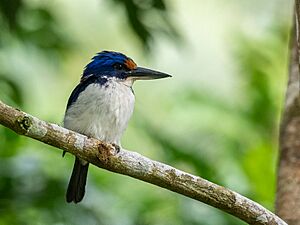Winchell's kingfisher facts for kids
Quick facts for kids Winchell's kingfisher |
|
|---|---|
 |
|
| Conservation status | |
| Scientific classification | |
| Genus: |
Todiramphus
|
| Species: |
winchelli
|
| Subspecies | |
|
|
| Synonyms | |
|
Todirhamphus winchelli (Sharpe, 1877) [orth. error] |
|
The Winchell's kingfisher (Todiramphus winchelli), also called the rufous-lored kingfisher, is a special type of bird in the kingfisher family. It is found only in the Philippines. This bird lives in lowland forests. Sadly, its home is disappearing because of deforestation. Because of this, scientists say it is a vulnerable species, meaning it is at risk of becoming endangered.
Contents
About Its Name
Scientists give every animal a unique name. The Winchell's kingfisher was first described in 1877 by a British bird expert named Richard Bowdler Sharpe. He used a bird specimen collected by an American expert, Joseph Beal Steere. The bird was named after an American geologist, Newton Horace Winchell, as a special request.
Scientists have also found five different types, or subspecies, of Winchell's kingfisher. These subspecies live in different parts of the Philippines. For example, one type lives in central Philippines, while another lives on the island of Mindanao.
What Does It Look Like?
The Winchell's kingfisher is about 25 centimeters (10 inches) long. Its head is a dark blue-black color with bright blue edges. It has a reddish-brown patch near its eyes and a reddish-brown collar around its neck.
Most of its upper body is dark blue and black, but its lower back (rump) is a bright, shiny blue. Male kingfishers have white undersides, while females have a buff, or light brownish-yellow, color on their bellies. Their eyes are dark brown, their beaks are black, and their legs are grayish. Young kingfishers look similar to the females but have duller colors. The different subspecies can have slightly different shades of blue.
Where It Lives
This kingfisher lives only in the Philippines. It can be found on islands like Samar, Tablas, Mindanao, Basilan, and the Sulu Archipelago. On some islands, you might see many of them, but on others, they are quite rare.
They prefer to live in forests that are less than 1,000 meters (3,300 feet) high. This includes forests near the coast and in the foothills of mountains. Scientists are still learning how well these birds can survive if their forest homes are damaged.
Daily Life and Habits
Winchell's kingfishers often sit high up in the trees, in the forest canopy. Sometimes, they fly down to lower branches or even to the ground, probably to find food.
They make different sounds. One call is a series of harsh "chup" and "chep" notes that get higher in pitch. Another call starts with three rising notes, then a long series of descending "chu chu chu chu" sounds. People have also heard them make loud squawking noises.
These kingfishers eat large insects, spiders, and small animals. When they catch their prey, they often hit it against something to make sure it's ready to eat. Not much is known about how they raise their young. However, one record shows them nesting in an old termite nest in a tree.
Why It Needs Our Help
Scientists estimate there are only about 2,500 to 9,999 adult Winchell's kingfishers left in the wild. Their numbers are quickly going down. The main reason for this decline is habitat loss. Forests where they live are being cleared for other uses, and there is also illegal logging.
Because of these threats, the International Union for Conservation of Nature (IUCN) has listed the Winchell's kingfisher as a vulnerable species. This means it faces a high risk of becoming endangered in the wild. Some of these birds have been seen in protected areas, like Mount Guiting-Guiting and Rajah Sikatuna Protected Landscape, which helps protect them.


